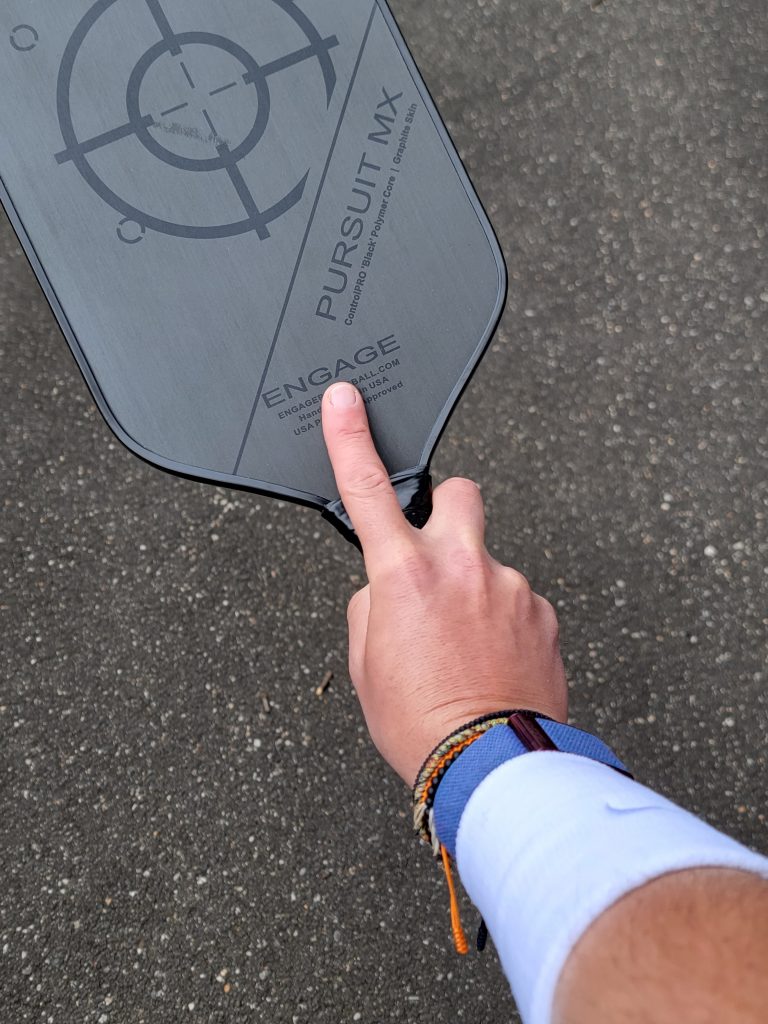I don’t play ping pong often, but when I do, I place my index finger on the face of the paddle with a finger-up grip. So perhaps I shouldn’t be surprised that this habit of extending my finger north of the grip carried over to pickleball.
Many pickleball players view this as an unorthodox or even improper way to hold the paddle, but I’ve stuck with it for some time now, and it’s been effective, specifically at the non-volley zone line.
However, the grip comes at a price.
The Pros of the Finger-Up Grip
More Control – Having my index finger on the paddle face gives me an intuitive feel for the paddle angle at the kitchen. I find it easier to put delicate touch on dinks, drops, and resets.
Spinning Service – Some people use the pickleball paddle finger-up grip to load up on topspin. Personally, I do not use it from the baseline or when serving, but some people feel they can generate additional spin.

The Cons of the Finger-Up Grip
Lack of Power – This is the biggest knock on the finger grip. Since my hand can’t get all the way down the handle while keeping a finger up, losing some leverage and whipping ability should be expected. Generating easy power on drives is tougher for me than traditional grips.
Backhand Mess – A two-handed backhand with a finger up feels like an awkward proposition. In my time on the court, I’ve seen very few players use the finger-up grip on a backhand. Instead, many of them switch hands. Oy!
Finger Injuries – A serious risk of the finger-up grip is taking a direct shot on that exposed index finger. It’s happened to me quite a few times. While I’ve skirted serious injury, there was one time I got nailed during warm-ups before a tournament, making me second-guess using an exposed finger for my matches.
Transition to Traditional Grip
How can a player smoothly transition from the finger-up grip to a more traditional grip, especially if they’ve used the finger-up grip for a long time?
Transitioning smoothly from the finger-up grip to a more traditional grip can be challenging, especially if a player has used the finger-up grip for a long time. The key is to take a gradual approach and be patient with the process. Start by incorporating the traditional grip during warm-ups and drills, gradually increasing the duration as it becomes more comfortable.
Experiment with different traditional grip variations, such as the Continental, Eastern, or Semi-Western, to find the one that suits your playing style best. Incorporate grip-specific drills and shadow swinging to reinforce the new grip pattern. Seeking guidance from a coach or experienced player can also help provide feedback and adjustments to your technique. It’s important to be prepared for an initial dip in performance as your body adapts to the new grip, but trust the process and remain consistent.
Alternative Techniques for Control
Are there other techniques or grip adjustments that can provide similar control and touch on the ball without the risks associated with the finger-up grip?
Other techniques and grip adjustments can provide similar control and touch on the ball without the risks associated with the finger-up grip. One option is to employ a semi-Western or Eastern grip, which can provide ample control while keeping the fingers on the beveled edge of the grip. Additionally, experimenting with grip pressure and firmness can enhance touch and feel, as a slightly looser grip can allow for greater control. Players can also utilize different grip positions for specific shots, such as a more Continental grip for volleys and a Semi-Western for groundstrokes. Focusing on developing a soft and relaxed grip, allowing the racket to move fluidly through the hitting zone, can also contribute to better control. Lastly, incorporating more wrist and arm flexibility into your strokes, rather than relying solely on hand and finger manipulation, can help achieve greater control without the risks of the finger-up grip.
Protective Pickleball Measures
What protective measures or equipment can players use to mitigate the risk of finger injuries when using the finger-up grip?
While the finger-up grip can pose risks of finger injuries, there are protective measures and equipment that players can use to mitigate these risks. Wearing protective finger sleeves or finger tape can provide cushioning and support for the vulnerable fingers.
Using an overgrip or a softer replacement grip can reduce the impact and vibration on the fingers. Considering a paddle with a larger grip size or a more shock-absorbing frame can also help distribute impact forces more evenly. Strengthening the forearm and hand muscles through specific exercises can improve grip strength and stability.
Properly warming up before play and incorporating stretching exercises for the fingers, hands, and wrists is also crucial. It’s essential to listen to your body and take breaks or adjust your grip if you experience discomfort or pain in the fingers. By weighing the benefits of the finger-up grip against the potential risks and making an informed decision based on your playing style, skill level, and personal preference, players can mitigate the risks associated with this grip technique.
The finger up grip is somewhat of a niche preference. Many players start with it from a table tennis habit but eventually transition to more traditional grips as they advance. For me, the trade-off for extra control on touch shots is still worth it at this stage of my game. But I can certainly see the benefits of developing a more orthodox grip down the road for extra versatility. Every player needs to weigh their own priorities when it comes to grips. Just be cautious of that exposed finger!

1 thought on “How to Hold a Pickleball Paddle With a Finger-Up Grip”